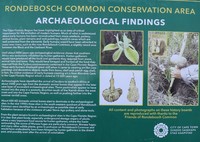Endangered Languages Digital Library
This Endangered Languages Digital Library[3] is a special collection showcasing all the published information and knowledge resources, formally and informally, ever done on the subject of southern African communities whose cultural heritage and language have become endangered.
This library has two unique aspects:
- An open-access library of full-text resources; and
- A catalogue that directs people to available knowledge and information resources which do not reside in the public domain.
Copyright Issues:
If there is any relevant information resource that you have ownership of and would like to make it discoverable and accessible via this library then please complete this form to participate in this process of information and knowledge sharing.
Search the archive here: https://ibali.uct.ac.za/s/san-khoen-digital-archive/literaturesearch2
[3] The works housed on this collection exist in the public domain due to the following reasons:
- Its copyright license has expired.
- It was published by either the author or the publisher using Gold or Green Open Publishing standards and platforms.
- It was published under a Creative Commons License.
- Permission was given by the relevant author(s) and/or publisher to make the work available to the public through our digital library.
Publications
-

Ambiguity is my middle name: A research diary
The story of Sarah Bartmann teaches nothing if it does not teach you who you are. Researching her life and talking to people about her I found out that I would remain a brown woman, no matter how many strings of degrees I trailed around behind my name. My race and my gender followed me, even into my academic work. Simply put, my experiences of being black and a woman writing about Sarah Bartmann have proved to be germane to a study of her historiography. Thus, this chapter deals with my relationship with the academic world of knowledge surrounding the Sarah Bartmann story. In the first half of the essay I deconstruct the uses and abuses of Sarah Bartmann in current academic discourse. I then move on to a discussion of my experience teaching this material in racially mixed settings at the University of Cape Town (UCT). The chapter ends with a discussion of my quest for self-understanding and self-retrieval from the obscurities of a language not created for my benefit. My intention is to produce a turn-around polemic against the racist and sexist cultural texts that silenced me through their animosity, and thus contribute towards the communal project of creating a more hospitable mental environment for African creativity. It expresses my human need to understand, come to terms with, and move on from, the dominant Bartmann historiography. -
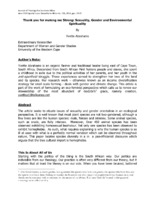
Thank you for making me strong: Sexuality, gender, and environmental spirituality
The article seeks to situate issues of sexuality and gender orientation in an ecological perspective. It is well known that most plant species are not two-gendered, although a few trees are like the human species: male, female and intersex. Some animal species, such as snails, are fully intersex. Moreover, over 450 animal species has been observed exhibiting homosexual behaviour. Yet only one species has been observed to exhibit homophobia. As such, what requires explaining is why the human species is so ill at ease with what is a perfectly normal variation which can be observed throughout nature. This paper locates species diversity in a in a pan-Africanist discourse which argues that the true cultural import is homophobia. -
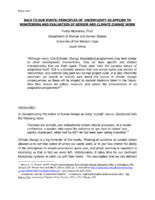
Back to our roots: Principles of uncertainty as applied to monitoring and evaluation for gender and climate change work
In deconstructing the notion of human beings as living ‘outside’ nature, Glazebrook tells the following story: “Humans are animals, and embodiment entails natural processes. At a recent conference, a speaker who urged the audience to ‘get back to nature’ was quickly challenged: when had he left? He had been seen eating breakfast.” Climate change is a big reminder of this reality. Thinking of ourselves as outside nature allowed us to not take notice of where our waste went, or to see how limited the ability of the atmosphere to absorb greenhouse gases was, and global warming is important in reminding us that in fact we never left. Unfortunately, it takes time for our dominant knowledge systems to catch up with that reality. The assumption that we can abstract from nature sufficiently to pursue a neat and tidy experimental method still underlies much development work. However, with climate change, we are increasingly being forced to accept that such an approach is not useful. Instead we are better off conceding the principle of uncertainty: not only can we not know everything we need to know, we also will never be sure quite how much we do not know. Throughout this essay, I will be using food supply as a practical example, since it is not only a deeply gendered process, but also a timely reminder of the fact that we never left nature behind. This essay looks at how to apply the principle of uncertainty to monitoring and evaluation (M&E) of gender and climate change work. It is necessary to pay analytical attention to this problem, since M&E of climate change adaptation is widely agreed to be different from previous development work. It has been observed that best way to approach the issue is to negotiate principles of M&E in the initial stage of project planning. However, so far it has not been possible to do this for the simple reason that the first few projects did not know what to expect. Now, however, we are in a better position to begin to develop a gender-specific methodology for climate change adaptation. This will come in handy for people planning future projects. -
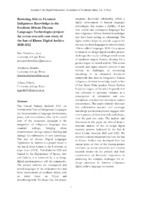
Restoring African Feminist Indigenous Knowledge in the Southern African Human Languages Technologies project: An action research case study of the San tsî Khoen Digital Archive 2020-2022
The United Nations declared 2019 the International Year of Indigenous Languages for the promotion of language development, peace, and reconciliation. One of the stated aims of the awareness campaign is the integration of indigenous languages into standard settings, bringing about empowerment through capacity building and through the elaboration of new knowledge. The San tsî Khoen Digital Languages Application & Archive is a project based in the San & Khoi Centre at the University of Cape Town (UCT). Established in 2020 and funded by the Department of Sports, Arts and Culture, it is informed by a co-design digital curation process with the community. The project archives the endangered and erased languages of the indigenous San and Khoi communities of southern Africa, with an initial focus on N|uu and Khoekhoegowab. To obtain this, the project integrates decolonial scholarship within a digital environment of human languages technologies that creates a visibility of not only erased and endangered languages but also indigenous African feminist knowledges that have been lacking in scholarship. The digital archive hopes to provide support for the case for these languages to become South African official languages. With this purpose in mind, its co-design digital curation process challenges the insular and fragmented nature of academic output, thereby allowing for a greater degree of critical analysis. This action research and digital curation process is not without its challenges, as co-creating knowledge in an attempted decolonial framework that aims to foreground African indigenous feminist knowledge (such as that of last fluent Nluu speaker, Ouma Katrina Esau) in a region of historical linguicide that was subjected to epistemic violence, as a consequence of colonialism and neo-colonialism, is in itself not without its various contestations. This paper critically discusses this collaborative research and co-design knowledge production process engaged with over a process of forty research workshops, over the past two years. The analysis and discussion in this paper are derived from a thematic analysis of this co-design digital curation process facilitated by the San & Khoi Centre between 2020 and 2022. We provide a critical perspective on how the San tsî Khoen Archive was developed from the unique point of view of the women project members (as senior researcher and curation research interns on the project) and their consideration of decolonial imperatives in addressing the complex challenges for co-design processes in feminist indigenous digital archive language restoration. -

Miscast: Negotiating the presence of the Bushmen
In this book, eminent scholars explore the term 'Bushmen' and the relationships that gave rise to it, from the perspectives of anthropology, archaeology, comparative religion, literary studies, art history and musicology. Topics as diverse as trophy heads and museums, to the destruction of the Cape San, and appraisals of 19th-century photographic practices are examined. A parallel text runs thoroughout the book and provides a counter narrative to the central discourses. The book is richly illustrated with previously unpublished photographs and documents from many archives and museums. -
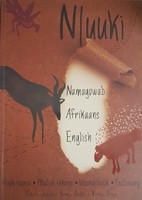
N|uuki, Namagowab, Afrikaans, English : ‡Xoaki‡xanisi, Mîdi di ‡Khanis, Woordeboek, Dictionary
This dictionary features two dialects of the N|uu language (Eastern and Western), as well as Nama, Afrikaans and South African English. This dictionary was not simply translated in standard varieties of Nama and Afrikaans, but was based on fieldwork conducted with speakers of these languages living in previously N|uu-speaking areas, i.e., South African Nama and 'Onse Afrikaans'. These languages and dialects show evidence of their influence on one another over time. -

Man Wat Die Wind Vervloek Het en Ander Stories Van Die Karoo
This is a selection of tales gathered in Afrikaans from present-day Karoo storytellers. They animate the harsh but beautiful landscape with lively characters like cunning Jackal, silly Hyena, dangerous Water Snake and the sinister Foot-Eyes. Such tales were first documented among |xam hunter-gatherers in the 1870s by Wilhelm Bleek and Lucy Lloyd. Unexpectedly they have survived, affirming a strong and continuing tradition of oral storytelling in South Africa. They’re presented here with English translation. -
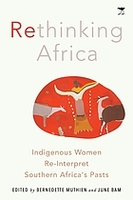
Rethinking Africa: Indigenous Women Re-interpret southern Africa’s pasts
This book critically opens new pathways for de-colonial scholarship and the reclamation of indigenous self-definition by women scholars. Indigenous peoples around the world are often socially egalitarian and gender equal, matricentric, matrifocal, matrilineal, less violent, beyond heteronormative, ecologically sensitive, and with feminine or two-gender deities or spirits, and more. Bernedette Muthien has contributed to several publications over the years, while June Bam has made numerous key contributions in the field of rethinking and rewriting the African past more generally. In this book, indigenous women write their own herstory, define their own contemporary cultural and socio-economic conditions, and ideate future visions based on their lived realities. All chapters herstoricise the accepted 'histories' and theories of how we have come to understand the African past, how to problematise and rethink that discourse, and provide new and different herstorical lenses, philosophies, epistemologies, methodologies and interpretations. In a first of its kind in Africa and the world, this collection of essays is written by, with and for indigenous southern African women from matricentric societies. Contents Foreword / Lungisile Ntsebeza -- I've come to take you home : a tribute to Sarah Baartman / Diana Ferrus -- Introduction / June Bam and Bernedette Muthien -- 1. Writing ourselves back into history : the liberating narrative of who we are / Sylvia Vollenhoven -- 2. Rematriation : reclaiming indigenous matricentric egalitarianism / Bernedette Muthien -- green kalahari / Bernedette Muthien -- 3. Gendering social science : Ukubuiswa of maternal legacies of knowledge for balanced social science studies in South Africa / Babalwa Magoqwana -- 4. Feminism-cide and epistemicide of Cape herstoriography through the lens of the ecology of indigenous plants / June Bam -- The bones / Diana Ferrus -- Camissa / Khadija Tracey Carmelita Heeger -- call to art / Shelley Barry -- 5. Valuing the increased and invisible workload : indigenous women, labour and the COVID-19 pandemic / Sharon Groenmeyer -- 6. Decolonising the representation of indigenous women at the Cape during Covid-19 / June Bam and Robyn Humphreys -- 7. Repositioning !uiki Ilnaosa/aia/ / gertrude fester-wicomb -- 8. Ancestral letter to unborn descendants / Sarah Malotane Henkeman -- 9. The falling sky : some notes about originary peoples in Brazil / Ana Lígia Leite e Aguiar -- Conclusion / June Bam and Bernedette Muthien -- one & many / Bernedette Muthien. -

Ausi told me: Why Cape Herstoriographies Matter
Ausi Told Me: Why Cape Herstoriographies Matter provides fascinating insights into life at the Cape over several centuries, the indigenous inhabitants and their accumulated knowledge, and how attempts were made to systematically erase this knowledge during the colonial and apartheid eras. Yet the wisdom of the ages still resides with the Ausidi, the female, intergenerational knowledge-keepers who are revered for the central role they played in Rondevlei, Hardevlei and other communities on the Cape Flats before the forced removals from the 1960s onwards changed the landscape forever. The book delves into many of the untold stories of the Cape, challenging various scholarly assumptions about the origins and enduring influence of the Khoi and San in the languages and cultures of southern Africa. The meticulously well-researched text is also skilfully interwoven with stories from current and former residents of the Cape Flats who speak candidly about their childhood experiences, the vast expanses of plants and flowers that used to more than satisfy local communities’ food and medicinal requirements, and the Ausidi – the formidable yet selfless family matriarchs, many of whom refused to be cowed by the apartheid regime’s forced removal policy and fought to protect their cherished livestock and land. Ausi Told Me: Why Cape Herstoriographies Matter serves as a reminder that popular history is not unassailable; it should be regularly questioned and, where necessary, challenged. The book makes a powerful case for a decolonised approach to exploring and interpreting southern Africa’s neglected past – in which the stories, dreams, visions and rituals passed down through the generations are recognised once more as critical sources of scholarly knowledge and physical and emotional wellbeing. -
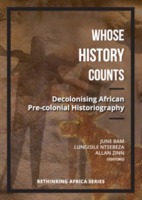
Whose history counts: Decolonising Pre-colonial Historiography
Originally planned as a fact-based book on the pre-colonial history of the Eastern Cape in the true tradition of history, this ground-breaking book focuses on epistemological and foundational questions about the writing of history and whose history counts. Whose History Counts challenges the very concept of "pre-colonial" and explores methodologies on researching and writing history. The reason for this dramatic change of focus is attributed in the introduction of the book to the student-led rebellion that erupted following the #RhodesMustFall campaign which started at the University of Cape Town on 9 March 2015. Key to the rebellion was the students' opposition to what they dubbed "colonial" education and a clamour for, among others, a "decolonised curriculum". This book is a direct response to this clarion call. -
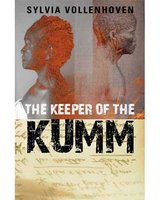
Keeper of the Kumm
Too much of South Africa’s history has been lost and suppressed, leaving a void for many South Africans. Sylvia Vollenhoven brings together her life and that of a long-ago ancestor, Kabbo, a respected Khoisan storyteller. She writes of her experience as being “too black” for her coloured schoolmates, working as one of the early female journalists in the misogynistic environment of the 70s, and of the constant impact on her life of her background – including her ancestors. To learn more about this resource read: http://www.thejournalist.org.za/wp-content/uploads/2014/08/The-Keeper-of-the-Kumm-Aug-2014.pdf -

Toponymica Hottentotica: B (A-Z)
This volume contains the information derived from the second of phase of the authors research project on Khoikhoi topographical names. It provides further insights into the motivations behind Khoikhoi place naming conventions.
External Digital Collections
-

Khoelife
-

Google Map of Indigenous Place Names
The map of indigenous place names located in the San tsî Khoen Digital Archive is duplicated on Google Maps in order to make the information more accessible. -

San & Khoi Centre YouTube Channel
Critical video material generated by the San & Khoi Centre is duplicated on our YouTube Channel to provide alternative access to these resources. -

Endangered Languages Digital Archive on archive.org
The Endangered Languages Digital Archive is maintained by the San and Khoi Unit at the University of Cape Town. The research unit is the result of a partnership between UCT, traditional San and Khoe leadership structures and non-governmental and civic organisations. The archive aims to be a central resource for all extant material related to San and Khoe languages (Khoe-Kwadi, Kx'a and Tuu language families). The open access publications found in the San tsî Khoen Digital Library is duplicated on archive.org to provide alternative access to these resources. -

Multilingual Dictionary: DSAC and African Tongue
This is a dictionary portal for the N|uu language with accompanying translations in Nama, Afrikaans and English. You can search for any of the included target words in N|uu, Nama, Afrikaans, or English. To assist with learning the pronunciation of the language, N|uu words are also transcribed into the International Phonetic Alphabet (IPA). Additionally, audio recordings from mother tongue speakers are provided as clear examples of how the language sounds. Sadilar hosts a digital version of the dictionary; see below link. Saasi Epsi is an app based on this digital dictionary; see below link. -
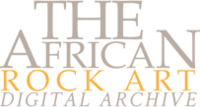
The African Rock Art Digital Archive
The Rock Art Research Institute (RARI) has a substantial collection of historical documents, photographs, redrawings and slides in addition to its large working collection of slides, tracings and redrawings. Over time, many of the older slides started to change colour and deteriorate in quality, prompting a programme to preserve the historical documents, photographs and slides in RARI's possession and reduce their handling by researchers and visitors. Preservation was possible by digitising the collections and making them available on a database, thereby reducing physical handling while facilitating access to images and documents. The Ringing Rocks Foundation provided the necessary funding for this project and in January 2002 the Digital Laboratory was named in their honour. The laboratory had the daunting task of digitising all the existing archives at RARI as well as providing a database from which the archives could be accessed and viewed. Moreover, with the specification for the database being agreed upon, RARI hired a London-based company called System Simulation Ltd (SSL) to develop the much-needed software for the database. The Ringing Rocks Digital Laboratory started its digitisation process in August of 2002. During the course of digitisation, RARI realised that it could use the expertise and equipment it has access to through the Ringing Rocks project to record other important collections, both private and institutional. This vision culminated in the South African Rock Art Digital Archive (SARADA), a resource that includes collections owned by the Analysis of Rock Art of Lesotho (ARAL) project, Iziko Museums of Cape Town, Natal Museum, National Museum (Bloemfontein), University of Cape Town (UCT), the University of South Africa (UNISA), RARI and Janette Deacon (private collection). The scope of this project was funded by the Andrew W Mellon Foundation. With the end of the Ringing Rocks project in February of 2005, preparations were under way to start digitising the collections as part of the SARADA project. By August 2005, ARAL was being digitised. The goal of the Ringing Rocks Digital Laboratory and The African Rock Art Digital Archive (SARADA) is to digitise rock art collections on the African continent, make them available in an easily searchable database, in so doing conveying the importance of protecting and preserving the continent's rich archaeological heritage and facilitating ongoing research and interest in its fascinating past. Collections include slides, historical documents, tracings, redrawings, renderings, prints, sketches and photographs. -

ǂKhomani San - Hugh Brody Archive
The ǂKhomani San are the first people of the southern Kalahari. They lived as hunters and gatherers in the immense desert in the northwest corner of South Africa. For them, it was a land rich in wildlife, plants, trees, great sand dunes and dry riverbeds. When the ǂKhomani San share their history, they tell a story of dispossession from their lands, erasure of their way of life, and disappearance of their language. To speak of their past is to search in memory for all that was taken from them in the colonial, apartheid and post-apartheid era. But they also tell a story of reclamation and recovery of lands, language and even of memory itself. They tell a story of struggle to emerge from the losses of the past, to put in place a new story. The collection presented here includes: photographs, posters and maps, trailers from the 'Tracks across Sand' documentary, and interview transcripts. -
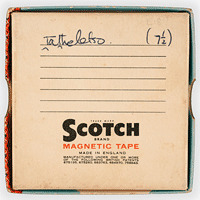
Ernst Westphal: San Languages
Westphal was Professor of African Languages at UCT between 1962 and 1984, and is best known for his contributions to the studies of non-Bantu click languages, lumped together under a misleading cover term ‘Khoisan’ by other scholars. The Westphal sound files are precious because they include recordings of some languages, which are no longer spoken and of which there is no written record. The collection presented here includes sound files and manuscripts. -
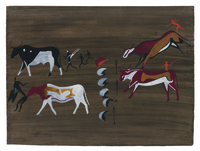
George Stow Digital Archive
The George Stow Digital Archive includes the copies of rock paintings made by polymath George Stow in the mid 19th century, as well as a selection of his field notebooks, letters and maps. George Stow was an Englishman who relocated to the turbulent Eastern Cape in the early 1840s. He became interested in many aspects of South African history and landscape, undertaking extensive geological surveys, taking up various posts, publishing poetry, and researching and writing an extensive history of the ‘Native Races’ of southern Africa. He made several hundred copies of rock paintings, trekking thousands of miles across the countryside and interviewing San wherever he could on the meanings and use of the art. Today his copies are amongst the loveliest records of paintings, revealing as much about the rock art itself as about Stow and the ideas he had about them. George Stow’s archive, housed mainly at the National Library of South Africa, Iziko South African Museum, the McGregor Museum and the University of Cape Town, includes astonishing collections of detailed maps, field notebooks, letters, drawings, manuscripts and painted copies of rock paintings and engravings. The digital archive includes selections of the maps, notes and letters, and all the extant rock art copies. -
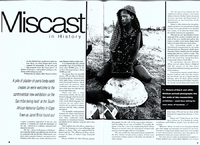
Miscast Archive
The Miscast archive, both digital and document, includes the documentary material collected as well as made for the exhibition Miscast: negotiating the presence of the Bushmen, held at the South African National Gallery in 1996 and curated by Pippa Skotnes. The Miscast exhibition opened to much publicity and generated vigorous debate during its five month showing. Part of the event was the first major debate amongst representatives of San and other groups from South Africa, Namibia, Angola and Botswana, organised by the curator. While the archive includes the physical residue of the exhibition, it also, more importantly, contains the photographs and documents collected as part of the research leading up to it, as well as the comments of visitors to the exhibition and many of the publications it generated. Currently, the archive includes a large collection of photographs assembled in two categories. One is the documentation of San objects and artefacts from collections in museums both in South Africa and London. These include skin bags, jewellery, tools and other artefacts such as divining disks, engraved walking sticks and decorated eggs. While this is not a comprehensive photographic database, it can give researchers a good idea of what is held, in South African museums in particular. The second is a collection of photographs (copies) of San subjects taken between 1858 and 1952 held in South African museums and museums in London (Pitt Rivers and British Museum) and Windhoek (the State Archives). Again, this is not a comprehensive collection, but is representative of collections held in these institutions. A selection of these have been digitised. There is also a collection of newspaper articles and archival documents on the subject of the San, collected mainly from the first three decades of the 20th century. The collection presented here is not the complete Miscast Archival contents. Rather, it documents elements of the exhibition mentioned above. This icludes: (i) the event reviews; (ii) the exhibition labels; and (iii) pictures related to the exhibition. -
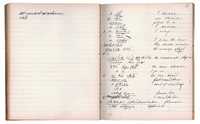
The Digital Bleek and Lloyd
This digital publication is part of a Llarec project to digitise, research and publish the Bleek and Lloyd Archive. The Digital Bleek and Lloyd includes scans of every page of the 110 Lucy Lloyd -
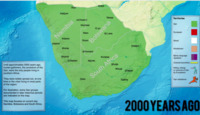
!Khwa ttu San Heritage Centre Featured Exhibitions: Enter the world of the San, southern Africa's First People
!Khwa ttu San Heritage Centre provides a platform for San to share and explore San history and culture among both San community members and local and international visitors. On their 'Featured Exhibitions' page the information on the following topics can be found: Genetics and Human Origins - !Khwa ttu has worked in co-operation with geneticists who are exploring how the San fit into accounts of the origins of all people from Africa. Eight videos are featured presenting the work of Brenna Henn, Carina Schlebusch and Himla Soodyall. The individual video topics include: (1) Why is our San history so important? (2) We are all from Africa. Do we come from southern Africa? (3) Are San descendents of the earliest people in southern Africa? (4) Are San first people? (5) Did your ancestors leave Africa 60,000 years ago? Or did they stay? (6) Who are the KhoeSan? How are the Khoe and the San different? (7) What is the relationship of Coloured people to KhoeSan people? (8) Do South Africans have KhoeSan ancestry? The Emergence of Human Creativity - Archaeologists describe four sites that provide us with information on the ancestral legacy and history of humanity in southern Africa. The archaeological sites include: Diepkloof Shelter, Pinnacle Point, Klassies River and Border Cave. Loss of San Land and Lifestyle - An animated video representating the land loss of indigenous people starting from 2000 years ago to 1965. The video was undertaken by Josh Cohen under the commission of !Khwa ttu San Heritage Centre. The San Healing Dance - The site offers a video entitled 'The last tribal dance' where people have the opportunity to witness a San healing dance by


